The Moodys at Eastern Cemetery
Seventh in a series of Occasional Papers about Eastern Cemetery in Portland, Maine
by Ron Romano
© 2019
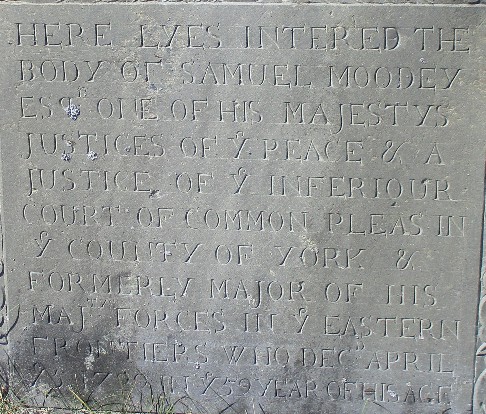
Figure 0. Transcription
Among the many contributors to the settlement, development, and character of Portland we find the names of Major Samuel Moodey and Captain Lemuel Moody. Though of different generations, with different spellings of their family name, and with burials in different sections of Eastern Cemetery, they were related — and at least 70 of their relatives rest near them. But their familial relationship was not defined in the published works by Portland’s classic historians (Goold, Moulton, Willis, and others). This paper confirms their relationship and provides details about some of their relatives who rest with them within the historic landscape of Eastern Cemetery.
Contents
- Part 1: The Line of Descent to Major Samuel Moody
- Part 2: The Line of Descent to Captain Lemuel Moody
- Appendix: Moody Family at Eastern Cemetery
- Sources
William Moody – The First to the New World
The man who brought the Moody name from England to New England was born around 1611. Though biographical sketches differ with respect to his place of birth, historians Sibley and Hoyt wrote that William came from Ipswich, on the eastern shore of England.1 All agree that William arrived in 1634 with the other founders of the town of Ipswich, Massachusetts. William "Moudey" is found on the passenger list that was created years after the actual journey of the Mary & John from London in the spring of 1634.2 Accompanying William Moody was his wife Sarah and two young sons, Samuel (age two or three) and Joshua (perhaps only one). Within a year, in 1635, the family moved just north with others, founding the town of Newbury where William received a grant of 92 acres of land. He was a saddler; Charles Moody wrote that William was also a blacksmith and was the first in New England to adopt the practice of shoeing oxen to enable them to walk on ice.
William and Sarah had a third son, Caleb, born in Newbury in 1637. As the three boys reached maturity, they joined their father in being important contributors to Newbury, serving on church committees and in town offices. Charles Moody wrote of these four men, "Indeed, almost all of the early Moodys were distinguished by the maturity and activity of their minds, and their uncommon intelligence, having exhibited an enlightened and far-reaching observation quite in advance of the age in which they lived."
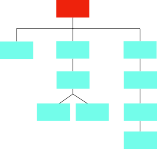
Figure 1
Throughout this paper, a small diagram of William Moody’s family tree is used to help the reader see where the particular person being addressed fits. In the diagram (Figure 1), William himself is in the red box at the top of the tree. The abbreviated tree includes only 10 of the more than 100 members of the family known to the author.
Part 1: The Line of Descent to Major Samuel Moody
Generation 2: Rev. Joshua Moodey (1633–1697)
Burial location: King’s Chapel Burying-Ground, Boston
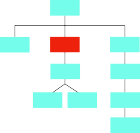
Figure 2
The middle son of William and Sarah, Joshua was born in England in 1633. His life unfolded into a rich New England story; his link to Portland is as father of one of our earliest and most important settlers, Major Samuel Moodey (c.1668–1729).
Joshua preferred the spelling "Moodey," which carried down to his sons but largely ended in that generation.3
Before turning to Major Samuel and Portland’s Eastern Cemetery, the story of his father is worth exploring. Here are some highlights from the life of Rev. Joshua Moodey:
- Arrived in Massachusetts as an infant in 1634
- Attended Harvard College, graduating in 1653, and becoming a clergyman
- Soon after college, married Martha Collins (1639–1674) of Cambridge, MA
- Moved to Portsmouth, NH, by 1658; began ministering in a new meeting house
- Organized a new church (the Church of Christ in Portsmouth) in 1671; appointed pastor
- Had at least four children with Martha (including Samuel, c. 1668)
- Lost his wife, Martha, in 1674. She was 35
- Married again in 1675 to a widow, Mrs. Ann (Wall) Jacobs (1640–1698)
- Had at least two more children with Ann
Perhaps the most interesting detail of Rev. Moodey’s life was his courageous opposition to the Salem witchcraft hysteria of 1692. His remarkable actions to save Philip and Susanna English from the gallows were detailed by Rev. William Bentley, who well knew the parties involved.
Philip English was a respected man "distinguished for property, and known in the commercial world;" Susanna "had received a better education than [was] common." Susanna was accused of being a witch in April 1692 and sent to the jail in Salem. Philip visited her there frequently over six weeks and soon enough found himself accused and in jail. When the Salem jail became filled to capacity, they were removed to Boston to await their trial.
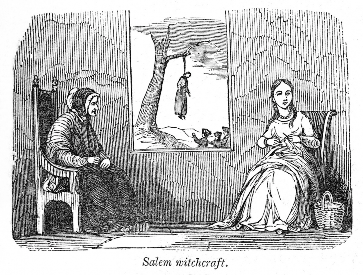
Figure 3. Source: A Pictoral History of the United States (1845)
Rev. Joshua Moodey had been ministering in Boston for eight years. He visited often with the accused couple, eventually befriending them. On the Sunday before they were to return to Salem for trial he invited them to attend his service.4 Harkening back to his own experience in Portsmouth, Moodey preached, "If they persecute you in one city, flee to another." He said that such flight was justified when one was falsely accused. Following the sermon, he asked the couple if they’d understood his message. Philip English replied that he did, but that their innocence would protect them during trial. Moodey knew better and told them that their lives were indeed in great danger. Susanna reasoned with her husband and convinced him to take the Reverend’s advice. That night, thanks to the careful secret arrangements made by Joshua Moodey, "several worthy persons" helped shepherd the couple and their child out of Boston to the safety of New York.
Following his brave actions to save the lives of Mr. and Mrs. English (and perhaps fearing the possibility of being implicated in their escape), Joshua decided to leave Boston and return to his old home of Portsmouth. He lived there for his final five years. He became quite ill in 1697 at the age of 64, and travelled to Boston for medical care. He died there on July 4, 1697 and was buried at King’s Chapel Burying-Ground in the tomb of a friend.5
In his will, Joshua Moodey included a message to his children, "...that they love one another dearly, and that there be no difference between them about any thing I shall leave them. And in order to the preventing of any difference, I advise them to meet as soon as they may after my decease, and discourse and share matters between them, while the remembrance of a dead father is fresh and warm upon their souls."
Generation 3: Portland’s first Moody—Major Samuel (c. 1668–1729)
Burial location: Eastern Cemetery, plot D-27
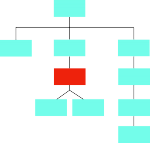
Figure 4
One of the children Rev. Joshua addressed in his will was Samuel, born around 1668 in Portsmouth NH. He graduated Harvard University in 1689 and followed his father’s path by preaching first in Hadley, Massachusetts, then in the Isle of Shoals, and later in Newcastle, New Hampshire. He married Esther Green of Boston in 1695 and four children are known. Their first child (born 1696) was named Joshua after Samuel’s own father, but he died within a few months. Their second son (born 1697) was also named Joshua and he survived to adulthood. A third boy (born 1699) was named Samuel, and a fourth child, a daughter named Mary, was born 1701.6 Joshua the second and Mary are buried at Eastern Cemetery and discussed later.
Samuel moved from the ministry to the military in the early 1700s, a career change that took the young family to Newfoundland Canada, where Samuel was commander of St. Johns Fort through about 1705. He returned to the Maine frontier a few years later in order to command the Fort at Casco Bay (no longer standing, but at the time located near the mouth of the Presumpscot River in Falmouth). When the fort was dismantled in 1716, the Moodys and other occupants of the fort relocated to Portland Neck.7 That move marked the beginning of this family’s 300-plus year presence in Portland, Maine.
Few whites lived on the Neck at the time Samuel Moody came—the area had been mostly cleared of settlers during the Indian wars of 1689-90. Moody’s request to build and arm a small fortification, along with houses for himself and the others who joined him, was approved in the summer of 1716. The petition noted that there were 15 men in the resettlement but did not provide the number of women or children who accompanied them. Samuel’s known family consisted of wife Esther and children Joshua, Samuel, and Mary; perhaps there were more children unknown to us today. He built his house along the beach about where Fore Street and Hancock Street meet today.
As the community continued to thrive and grow, Samuel helped established its religious base. Portland’s first minister, Rev. Thomas Smith, noted in his journal in June of 1725 that he was boarding with the Major and his two sons Joshua and Samuel (though curiously no mention of Esther). Moody’s was the largest house in the town. The Reverend boarded with Moody for two years, eventually being able to move into his own home. Moody hosted the schoolmaster for a while as well. He served Portland in many important roles: as Justice of the Peace, Selectman, Justice of the Court of Common Pleas for the county, and government negotiator with the local Indian chiefs. Willis said of him, "Major Samuel Moody may justly be called the leader of the little colony at Falmouth ... The acquisition of this respectable family was of great importance to the prosperity of the infant settlement. It gave strength to its hopes, and afforded encouragement to others to select this as their place of residence."
A Checkered Past
Though many settlers were considered pillars of their communities, the full stories of their lives sometimes contain details that are difficult to reconcile today. So is the case with Major Samuel Moody. The baptism records for the First Church in Falmouth contain these two entries:
"TRIPHENA, a negro child belonging to Maj. Moody, and born in his house, 1726."
"TRIPHOSA, a negro child belonging to Samuel Moody, who came under particular arrangements for its religious education, June 10, 1733."
The use of the words "belonging to..." tells us that these children were enslaved. The reference to Triphosa as "it" instead of "her" suggests that she was considered less than human.
Rev. Smith’s journal provides more detail related to this matter. In 1727, he wrote of a letter he’d received from the leader of the Boston Church which had come as a result of Smith’s seeking guidance from him regarding the baptism of a negro child born to a servant of Major Moody. The Boston pastor put the decision back onto Smith and the local church. He noted that he personally would do the baptism if the child were within his parish, but ceded the decision to Smith. If the church records are accurate, Triphena had already been baptized a year earlier, so the correspondence may have been referring to Triphosa or even another child.
The Major died four years before Triphosa8 was baptized. Her owner was referred to as "Samuel Moody" instead of "Major Moody," so clearly if she was alive as early as 1729, she was willed to the Major’s namesake son Samuel upon the Major’s death in 1729.
Samuel Moody’s Death
Major Moody died on April 5, 1729, and the gravestone erected in his honor notes that he was 59 at the time of death. In the table that follows, the transcription on the left is exact as found on the gravestone itself (Figure 0). On the right is the version published by Portland historian William Willis in 1849.
| Gravestone Transcription | William Willis Transcription |
|---|---|
| HERE LYES INTER’ED THE BODY OF SAMUEL MOODEY ESQr. ONE OF HIS MAJESTYS JUSTICES OF Ye PEACE & A JUSTICE OF Ye INFERIOUR COURT OF COMMON PLEAS IN Ye COUNTY OF YORK & FORMERLY MAJOR OF HIS MAJtys FORCES IN Ye EASTERN FRONTIERS WHO DECd APRIL Ye 5 1729 IN Ye 59th YEAR OF HIS AGE |
Here lies interred ye body of Samuel Moody, Esq., one of his Majesty’s Justices of ye Peace and a Justice of ye Superior Court of Common Pleas in ye County of York, and formerly Major of his Majesty’s forces in ye eastern provinces, who deceased April 5th, 1729, in ye 52nd year of his age. |
The most notable differences are shown in red bold font and include the spelling of last name (Moody vs. Moodey), name of the court (superior vs. inferior), reference to the territory (eastern provinces vs. eastern frontiers) and age at death (52nd vs 59th).
Willis then goes on to say this: "There is evidently an error in the age here given to Mr. Moody; for he graduated at Harvard College in 1689, forty years prior to his death, which would make him but twelve years old at the time; he was, more probably, in his sixty-second year."
But that’s not right either. The carving of the "9" in "59" may have caused some confusion to Willis (and others who used his findings in their own works), since it could be mistaken for a "2."
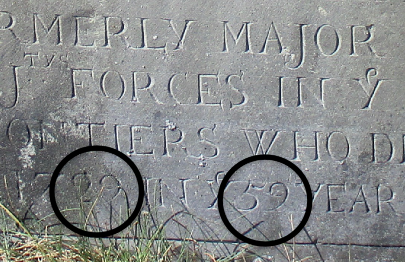
Figure 5. Detail of the marker for Major Samuel. Note that the "2" and "9" in the date 1729 on the left are similar to the "9" in the age of 59" on the right.
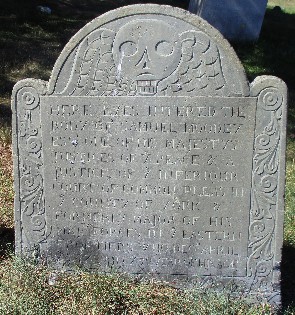
Figure 6. The full marker for Major Samuel, likely carved by William Codner.
The slate marker present on the grave today is similar in material, style, and appearance to others that were being produced in the early eighteenth century and therefore considered to be original. Since no stone-cutter lived in Portland until 1800, this and other early markers found at Eastern Cemetery today were made in Boston and shipped north. I asked Jim Blachowicz, an expert on colonial New England gravestones, for his opinion about the marker, and he concurred that it was likely carved within a few years of Samuel Moody’s death. Blachowicz suggested I review the work of two specific Boston stone-cutters as possible creators of this marker. I did that, and believe that the marker was carved by William Codner.9
The Oldest Area of the Cemetery
Samuel Moody’s stone is one of the oldest surviving markers at Eastern Cemetery, and it makes sense that he was buried in what’s considered to be the oldest area of the cemetery, which was designated the town’s burying-ground in 1668. The honor of having the oldest surviving dated stone goes to Samuel’s sister-in-law, Mary Green, who died in 1717. Her stone is located immediately beside her brother-in-law’s in the area now referred to as Section D.10
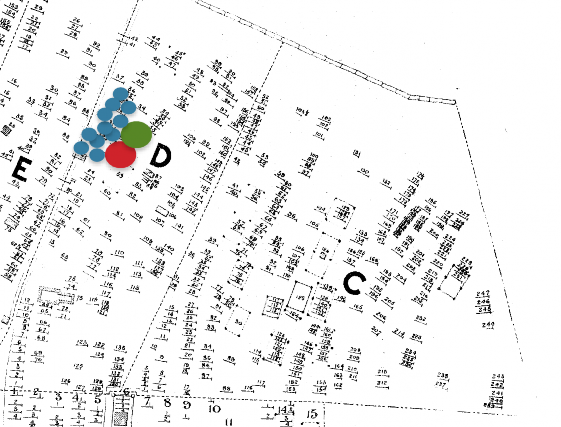
Figure 7. Detail of the 1890 survey map of Eastern Cemetery by William Goodwin. Red dot = Samuel Moody. Green dot = Mary Green. Blue dots = Children and other descendants of Samuel.
But what of Esther Green Moody, Mary’s sister and the wife of Major Samuel? Despite the wealth of information found about Samuel, little is known of her. She was the daughter of Nathaniel Green of Boston and born in 1675. She married Samuel Moody in Boston in 1695. But no stone is found for her at Eastern Cemetery, or anywhere else they lived. No vital record of death is known, and no clues to her death date or location are found in any of the many published works about Eastern Cemetery or the Moody family. Perhaps she died before Samuel relocated to Portland Neck in 1716? Or perhaps she died in Portland and is beside her husband in an unmarked grave? Maybe she outlived her husband and lived with her son in Brunswick? Her date of death and burial location remain a mystery.
There are at least a dozen relatives of Samuel Moody in this section of the cemetery. In fact, his daughter Mary Moody Mountfort and her family rest just one row east of Samuel, and she provides our next opportunity for discussion.
Generation 4: Mary (Moody) Mountfort (1701–1752)
Burial location: Eastern Cemetery, plot D-31
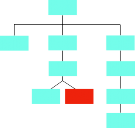
Figure 8
Spirits Alive, the Friends of Eastern Cemetery, has many success stories regarding conservation of grave markers, but an extraordinary example played out during the summer of 2018 that—unbeknownst to the conservation crew at the time of their work—happened to involve the Moody family.
A curious small part of a fallen marble gravestone was showing through the sod of Section D, the grass encroaching a bit more each year. It was clearly an unusual carving and worth exploring. As the conservation crew dug the stone from the ground and realized it was just a broken piece of a much larger stone, they probed the area for more. Ultimately, all the pieces were recovered from under the sod—the furthest piece about ten feet from the original.
Work to clean and repair the stone, and create a new base to support it took a few weeks. The result of the efforts was the placement of the original large, thick, white marble marker memorializing eight members of the Mountfort family, including the patriarch and matriarch Edmund Mountfort (1694–1737) and Mary Mountfort (1701–1751). It wasn’t until we looked more deeply into this family’s history that we realized Mary was actually Mary Moody, the daughter of the Major. The restored stone is shown here (Figures 9 & 10).
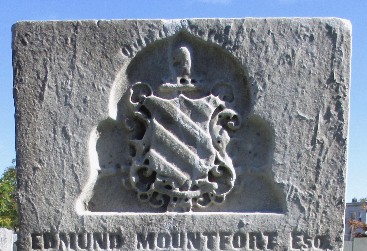
Figure 9
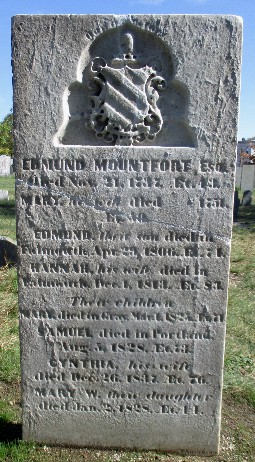
Figure 10
The stone features a family crest (somewhat eroded from years of weathering) along with the words "Our Ancestors" arching over the crest. The crew also found a carver signature on this stone: "Thompson," who certainly is Joseph Thompson, a prolific stone-cutter in Portland from the late 1820s for at least five decades. He was one of the two successors of stone-cutter Bartlett Adams, taking over the Adams shop upon his death in 1828.
Mary Moody, born 1701, was the daughter of Samuel and Esther. She married Edmund Mountfort, probably by 1725, as birth records for their six children run from 1726 through 1737. Edmund himself died that year, and Mary remained a widow to her own death about 15 years later. Also memorialized on this stone are Mary and Edmund’s son Edmund and his wife Hannah. Two more generations make up the remaining eight names. See the Appendix for a complete list of Moody family members buried and/or memorialized at Eastern Cemetery.
Generation 4: Justice Joshua Moody (1697–1748)
Burial location: Eastern Cemetery, plot location unknown
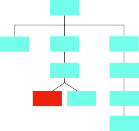
Figure 11
Joshua Moody was an older brother to Mary Moody Mountfort. He was born to Major Samuel and Esther Green while the family was at Newcastle, New Hampshire. Sibley referenced correspondence between Harvard schoolmasters regarding Joshua’s quest for the best roommate at school. One wrote that Joshua was, "...good humored and for good words will do anything, but is apt to be discouraged with harsh language which makes me the more concerned for who he lives with. If you’ll please do him the favor of taking him into your Chamber and take some Peculiar care of him and encourage him in his learning..."
But once he was placed, things didn't go so well. In 1714 he and a classmate were expelled from school for "Crimes," the details of which are unclear. In front of nearly the complete faculty and several classes of undergraduates, expulsion was determined to be the "least and lowest manifestation by which the Corporation (school) could show their resentments of the Outrage Committed by the Criminals..." Three months later, "the culprits were readmitted upon humble application and confession." The good news is that like his father Samuel and grandfather Joshua before him, he graduated Harvard College (in 1716).
From there, he returned to Portland to help his father, and ultimately became the town’s first clerk. After his father died in 1729, he became Justice of the Peace. Soon after, he married Tabitha Cox (1717–1756) in Portland in 1735, and they had three sons: Houtchin (1737), William (1740), and James (c. 1744). He fell ill in the winter of 1749, and with the town’s minister, Reverend Thomas Smith praying at his bedside, he died, leaving behind his wife and three sons. Of this branch of the family, only Joshua is buried at Eastern Cemetery, and unfortunately, his grave location within the burying ground is not known.11
Dr. Samuel Moody (1699–1758)
Also in generation 4, and brother to Joshua and Mary, Samuel Moody lived in Portland with his parents, graduated Harvard in 1718, then returned to Portland to serve as First Parish Clerk. He had studied medicine and was an Army surgeon for awhile, but ultimately removed to Brunswick where he commanded Fort George. He was the son who owned Triphosa, noted in baptism records. Doctor Samuel and his wife, Mary Wheelwright, had at least five children, but none from this branch are found at Eastern Cemetery.
Part 2: The Line of Descent to Captain Lemuel Moody
Part 1 explored four generations of Major Samuel Moody’s line from his grandfather to his children. This part explores four other lines of Moodys related to Captain Lemuel, who was Major Samuel’s first cousin, twice removed. The common ancestor to Major Samuel and Captain Lemuel was first settler William. He was Samuel’s grandfather and Lemuel’s great- great-grandfather. Their lines diverged in the second generation of William Moody’s family.
Generation 2: Caleb Moody (1637–1698)
Burial Location: Newbury, Massachusetts
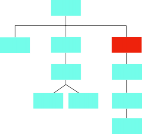
Figure 12
Caleb was Major Samuel’s uncle; he lived his life in Newbury, Massachusetts. He was married twice—to Sarah Pierce in 1659, and after her death in 1665 to Judith Bradbury. With Sarah, Caleb had two children, and with Judith he had eight more, including Joshua in 1671.
Generation 3: Joshua Moody (1671–1730)
Burial location: Newbury, Massachusetts
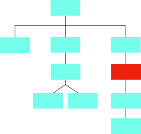
Figure 13
Joshua Moody was Major Samuel’s cousin, and Captain Lemuel’s grandfather. He lived his life in Newbury, Massachusetts. He married Mary Greenleaf in 1696, and together they had 11 children. Among them was Enoch, born 1713.
Generation 4: Enoch Moody (1713–1777)
Burial location: Eastern Cemetery, plot E-70
[and his wife]:
Ann Weeks (1733–1795)
Burial location: Eastern Cemetery, plot E-69
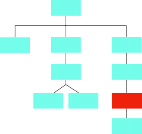
Figure 14
Enoch was the first in his line to leave Newbury, Massachusetts and move to Portland. He arrived in 1738, and married Dorcas Cox (1721–1743) a year later. He was 25. No children are known to have come from their short marriage, which ended with Dorcas’ death at the age of 22. She was buried at Eastern Cemetery at plot E-71, her grave marked by a broken slate that was created in one of the Boston stone shops.
Enoch remarried in 1750, to Ann Weeks, and together they had at least eight children—all of whom remained in Portland and are buried at Eastern Cemetery. Enoch built a large house at the corner of Franklin and Congress Streets, just a short walk to Eastern Cemetery, which survived at least 100 years and remained in the family until it was taken down. His land extended all the way from Congress Street down to Back Cove. He served Portland as selectman for some years. He died at age 63. His son Lemuel had not yet reached ten years of age. Ann Weeks lived another 22 years; her gravestone is a wonderful slate marker featuring a winged face carved by John Just Geyer of Boston.
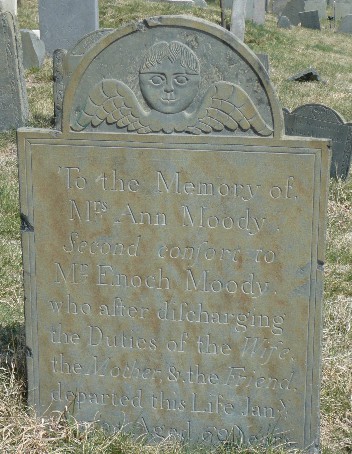
Figure 15
Ann Weeks Moody’s marker reads:
To the Memory of
Mrs. Ann Moody
Second consort to
Mr. Enoch Moody
who after discharging
the Duties of the Wife,
the Mother, & the Friend,
departed this Life Jan’y
29, 1795, Aged 62 Years.
(She is referred to as "second consort" which means she was Enoch’s second wife.)
Generation 5: Captain Lemuel Moody (1767–1846)
Burial location: Eastern Cemetery, Tomb A-60
[and his wife]:
Emma Crosby (1769–1849)
Burial location: Eastern Cemetery, Tomb A-60
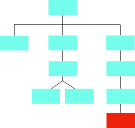
Figure 16
While Major Samuel Moody contributed to the settlement and development of Portland, Lemuel Moody surely contributed to its character, as architect and builder of the beloved Portland Observatory.
Lemuel was born in Portland in 1767, the sixth child of Enoch Moody and Ann Weeks. From his obituary in 1846, "Capt. Moody, like the sons of most of our old families ... embarked on the sea for livelihood. Our people were thoroughly commercial, their whole energies were employed ... in pursuits connected with the ocean; and our enterprising young men were therefore naturally drawn to that most exciting means of advancement in the world."
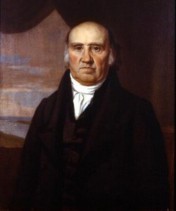
Figure 17. 1826 oil portrait of Captain Lemuel Moody, by Henry Cheever Pratt. The original is in the collections of the Maine Historical Society.
He married Emma Crosby (1769–1849) in Portland in 1797. Ten children were born to them over a twenty-year period, beginning in 1798. Half of those died in infancy and were buried at Eastern Cemetery. In fact, eight—likely nine—of their children were buried at Eastern Cemetery along with spouses and grand-children. One son, Enoch, was buried at Evergreen Cemetery across town when he died in 1870. One other son, Henry Watson Moody (born 1807), lacks clear death and burial records.
Capt. Moody followed the seas for many years, but his interests and activities were not limited to sailing. He produced a chart of Casco Bay in 1825 complete with depth measurements, to aid ships navigating their way in and out of the busy harbor. He recorded and maintained weather statistics. His legacy is the Observatory, a tower built on Munjoy Hill in 1807 that gave—and gives to this day—unparalleled views of the harbor. Of the Observatory, John Neal wrote in 1874, "There is no point in Maine where the view of sea or land is more delightful." Moody maintained a large collection of merchant flags at the tower, and when, through his scope located at the top, he saw a trade ship turn from the open sea into the entrance to the harbor, he’d raise the appropriate flag to signal the land-based owner of the approach of his cargo.
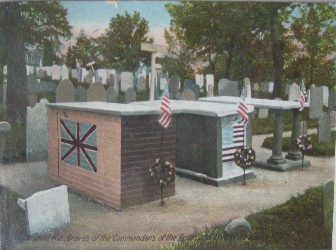
Figure 18. Postcard (early 1900s) view of the tombs. Left to right: Captain Blyth, Captain Burrows, and Lt. Kervin Waters.
The most visited site within Eastern Cemetery is the plot where Captains Samuel Blyth and William Burrows rest. They died in the famous battle of the HMS Boxer and USS Enterprise on September 5, 1813. William Goold wrote that Captain Moody, then age 46, climbed the tower on the fateful day, and witnessed the battle from afar. "Early on Sunday people began to gather at the Observatory. Its keeper, Captain Moody, was as anxious to make discoveries as any one. He admitted a few friends and the proprietors of the tower, but excluded all others... Captan Moody left his practiced eye to the glass... he saw the smoke of the Boxer’s challenge gun and that of the Enterprise accepting it. This discovery he communicated to the anxious crowd below, and a cheer went forth notwithstanding it was Sunday. ... The battle was fought on the open water inside of Monhegan [Island], forty miles in a direct line from Portland." The next day, the victorious Enterprise arrived home to Portland, with the defeated British ship just behind.
Captain Moody lived a good, long life. He died on August 11, 1846 at the age of 79. He was buried in the family’s tomb12 in Section A of the cemetery, joining a brother, son, two nieces, a nephew and other in-laws who had predeceased him.
Again, from his obituary published the same day of his death, "He died in the strength of his intellect and the mellowed ripeness of his affections; he will leave a space in this community which may not be easy to fill. It is an interesting fact, and well worthy of notice, that this very morning, previous to his death, he was on top of the Observatory, taking his accustomed observations around the horizon; thus making his final survey over the ocean and land, in the freshness of this beautiful morning, before taking leave of them forever, to enter upon a brighter and better world to which the telescope of his heart has long been directed."
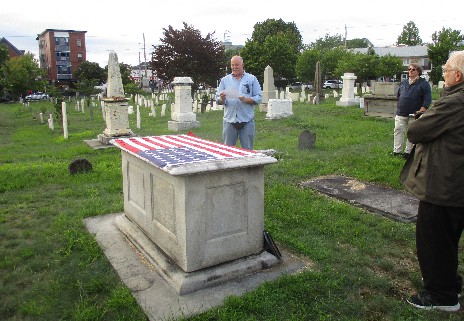
Figure 19. The Moody family tomb as shown on August 12, 2018, during a special event held to honor Captain Lemuel Moody on the anniversary of his burial at Eastern Cemetery. His direct descendant John York, a fourth great-grandson, read the Captain’s obituary from 1846.
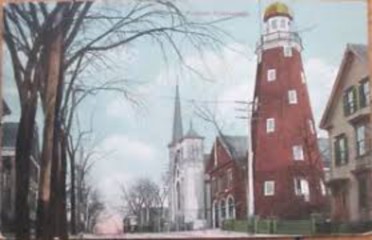
Figure 20. An early 1900s postcard view of the Observatory.
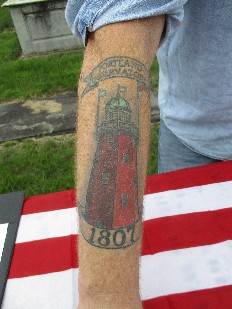
Figure 21. A body-art version of Moody’s Observatory, on the arm of John York.
Plot Locations at Eastern Cemetery
As noted in Part 1, the graves of Major Samuel and others in his immediate family are found in the oldest part of the burying ground (within red circle on the map: Figure 22). Captain Lemuel and 19 members of his immediate family are entombed in the Section A private family tomb (green circle).
Lemuel’s mother and father, plus his father’s first wife, join a few other family members in a small family lot in Section E (blue circle). Three Moodys have burial records confirming they were laid to rest in Eastern Cemetery, but plot locations are unknown and no gravestones for them have survived the ages. By far the largest Moody patch is found in Section G where, in a single line running from Funeral Lane down a gently-sloping hill towards Federal Street, rest at least 25 members of the family (yellow oval). This line contains a few worn white marble monuments along with a fine collection of slate gravestones carved by resident stone-cutter Bartlett Adams.
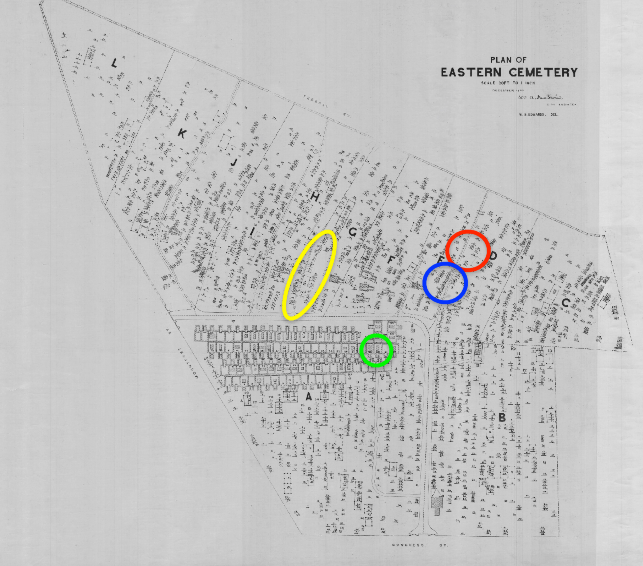
Figure 22
The Bartlett Adams Slates
Fifteen of the Section G markers are slates that were produced in the shop of Bartlett Adams. At least four carvers are represented: Bartlett, Elias Washburn, Alpheus Cary, and probably (but not certainly) Ira Washburn.
One of the best of this collection is for Molly Moody, 1799 (Figures 23 & 24). She was Lemuel’s sister-in-law by marriage to his older brother William. This is one of the first markers that Bartlett Adams carved for the Moody family, given the date (he arrived in Portland in 1800) and given its design and lettering. Perhaps it was the business transaction that introduced Bartlett Adams and Lemuel Moody to one another. For all of the gravestones that were produced in the Adams shop for the Moody family, they surely were well acquainted.
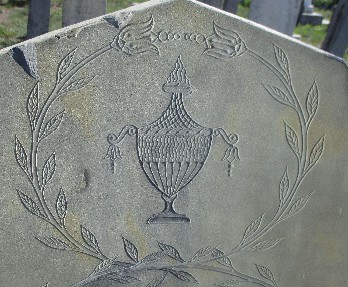
Figure 23
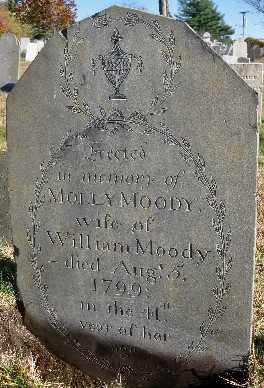
Figure 24
The urn on Molly’s marker is one of his earliest versions. The bellflower decoration, oval frame, and lettering all come from his initial years in his Portland shop.
Another fine stone from Adams is for Lemuel’s older brother, Captain Nathaniel Moody, 1815, featuring a rare full-sized urn, a broad-leafed willow, and Bartlett’s signature background stippling (detail, Figure 25).
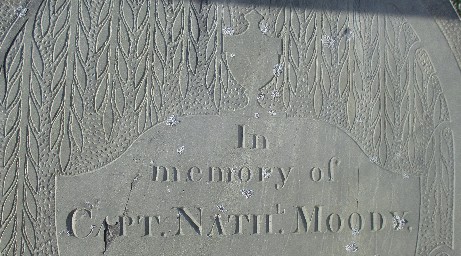
Figure 25
In his first decade in Portland (1800 to 1810), Bartlett was at his most creative, decorating stones with personified suns, rosettes, canopies and free-form flourishes, among the more common urns and willows. Some of these interesting designs appear on Moody family stones.
Bartlett’s rosettes are found on the markers for three infants: Henry (1803) and George (1804), who were Lemuel and Emma’s sons (they share a gravestone, shown in Figure 26) and Harriot Moody (1805), their niece, who has her own marker.
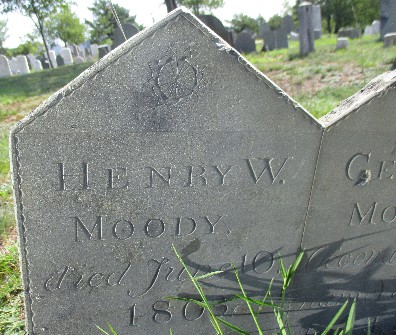
Figure 26
His interesting canopies adorn the markers for three more infants, all nieces of Lemuel: Polly and Eunice (1789) share a stone shown in Figure 27, while Harriot (1799) has her own.
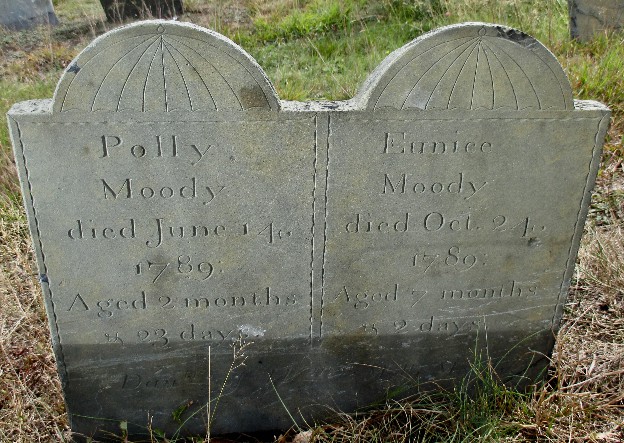
Figure 27
Alpheus Cary worked with Bartlett for just a couple of years (1806–1807) and carved Nancy Moody’s 1807 marker shown in Figure 28. She was niece to Lemuel. Note the exposed roots and tiny leaves on the tree, both typical for Cary. When he left the Adams shop, he moved to Boston, where he had a life-long prolific career in stone-cutting.
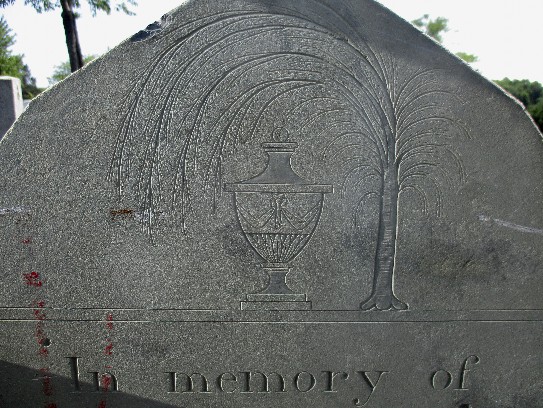
Figure 28
Bartlett Adams’ nephew Elias Washburn worked in the shop in the 1810s and 1820s, even taking over management of the shop for two years, 1818–1820, when Bartlett was in Boston with his brother. Elias carved matching markers for Lemuel’s brother Benjamin Moody (1816) and Benjamin’s wife Sally Richards Moody (1815)—featuring his own signature urn and willow design. Benjamin’s stone is shown in Figure 29.
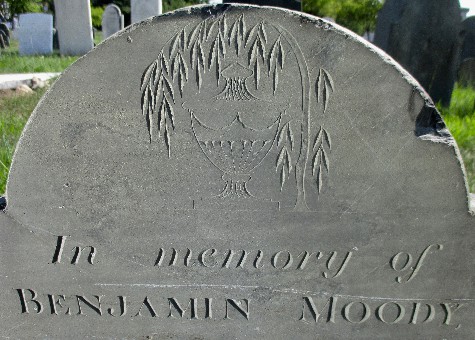
Figure 29
Summary
We now have a clear familial link between Major Samuel Moodey and Captain Lemuel Moody—first cousins, twice removed. Though they lived at different times and never knew one another, they left their marks on Portland. And with their many children and grandchildren, the Moodys became one of the best represented families at Eastern Cemetery where, in all, there are at least 72 known to be at rest.
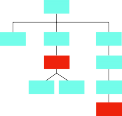
Figure 30
During our historical walking tours of the cemetery, Spirits Alive’s volunteer guides often bring visitors to the grave sites of the Major and Captain, describing their contributions to Portland and keeping their legacies alive.

Figure 31
Appendix: Moody Family at Eastern Cemetery
Key
- Grave: Listed by section & plot. "G-06" is section G, plot 06, and "B-14-21" is section B, row 14, plot 21
- Relation: Relationship to either Major Samuel or Captain Lemuel provided here
- Grave stone? If a stone is present on the grave, some detail provided here
| G-06 | Chandler | Jane | (Little) Moody | 1766 | 1824 | 58 | Lemuel’s sister-inlaw, via Nathaniel | slate | Bartlett Adams |
|---|---|---|---|---|---|---|---|---|---|
| B-14-21 | Loring | Rhoda | Moody | 1786 | 1824 | 38 | Major Samuel’s greatgranddaughter | slate | Bartlett Adams |
| D-27 | Moodey | Samuel, Major | - | c. 1670 | 1729 | 59 | Lemuel’s first cousin, twice removed. | slate | William Codner |
| E-69 | Moody | Ann | Weeks | 1733 | 1795 | 62 | Lemuel’s mother | slate | John Just Geyer |
| G-21 | Moody | Ann S. | Valentine? | 1783 | 1866 | 84 | Lemuel’s niece, by marriage to nephew Enoch, via William & Molly | Intact worn marble shared w/ Lucy and her infant daughter. | unknown |
| G-2 | Moody | Benjamin | - | 1753 | 1816 | 63 | Lemuel’s brother | slate | Elias Washburn |
| G-10 | Moody | Daniel S. | - | 1800 | 1821 | 21 | Lemuel’s nephew, via Samuel & Mary | slate | Bartlett Adams |
| B-04-07 | Moody | Desiah (Desire) | Humphreys | 1793 | 1850 | 57 | Lemuel’s niece, by marriage in 1821 to William Jr, via William & Molly | broken marble headstone, no lettering showing; footstone has DHM | - |
| E-71 | Moody | Dorcas | Cox | 1721 | 1743 | 22 | Lemuel’s father’s first wife | broken slate | Boston carver |
| A-Tomb 60 | Moody | Dorcas | - | 1764 | 1849 | 85 | Lemuel's sister | box tomb; eroded marble ledger slab | - |
| ? | Moody | Dorcas (1) | - | 1805 | 1807 | 2 | Lemuel’s daughter | - | - |
| G-19 | Moody | Edward | - | 1806 | 1823 | 17 | Lemuel’s nephew, via William & Rachel | slate, shared (cenotaph, as he died in Havana). | - |
| A-Tomb 60 | Moody | Emma | Crosby | 1770 | 1849 | 80 | Lemuel’s wife | box tomb; eroded marble ledger slab | - |
| A-Tomb 60 | Moody | Emma | - | 1798 | 1847 | 48 | Lemuel’s daughter | box tomb; eroded marble ledger slab | - |
| E-70 | Moody | Enoch | - | 1713 | 1777 | 63 | Lemuel’s father | broken slate by Boston carver, and new granite | - |
| E-66 | Moody | Enoch | - | 1751 | 1812 | 61 | Lemuel’s brother | slate | Alvan Washburn |
| G-22 | Moody | Enoch | - | 1787 | 1851 | 64 | Lemuel’s nephew, via William & Molly | veteran’s marker | - |
| G-13 | Moody | Eunice | - | 1789 | 1789 | 0 | Lemuel’s niece, via William & Molly | slate, shared | Bartlett Adams |
| G-20 | Moody | Frances | - | 1819 | 1821 | 2 | Lemuel’s nephew Enoch’s daughter, via William & Molly | marble, heavily eroded, shared | - |
| A-Tomb 60 | Moody | Franklin Crosby | - | 1814 | 1877 | 63 | Lemuel’s son | box tomb; eroded marble ledger slab | - |
| G-12 | Moody | George (1) | - | 1800 | 1801 | 1 | Lemuel’s son (relationship error in Jordan) | broken slate | Adams shop |
| G-11 | Moody | George (2) | - | 1801 | 1804 | 3 | Lemuel’s son | slate, shared | Bartlett Adams |
| G-14 | Moody | Harriot (1) | - | 1798 | 1799 | 0 | Lemuel’s niece, via William & Molly | slate | Bartlett Adams |
| G-17 | Moody | Harriot (2) | - | 1804 | 1805 | 0 | Lemuel’s niece, via William & Rachel | slate | Bartlett Adams |
| G-20 | Moody | Henry | - | 1813 | 1813 | 0 | Lemuel’s nephew Enoch’s son, via William & Molly | marble, heavily eroded, shared | - |
| A-Tomb 60 | Moody | Henry Franklin | - | 1848 | 1848 | 0 | Lemuel’s grandson, via Franklin & Lucy | box tomb; eroded marble ledger slab | - |
| G-11 | Moody | Henry W. (1) | - | 1803 | 1803 | 0 | Lemuel’s son | slate, shared | Bartlett Adams |
| G-21 | Moody | Infant daughter of Enoch & Lucy | - | unknown | 0 | Lemuel’s nephew Enoch’s daughter, via William & Molly | Worn marble shared w/ mother and father’s second wife Ann | - | - |
| F-123 | Moody | John | - | 1790 | 1818 | 28 | Unsure. Obit notes he was "of Haverhill." Buried far from others. | veteran’s marker | - |
| A-Tomb 60 | Moody | John Watson | - | 1810 | 1840 | 29 | Lemuel’s son | box tomb; eroded marble ledger slab | - |
| ? | Moody | Joshua | - | 1697 | 1748 | 51 | Major Samuel’s son | - | - |
| A-Tomb 60 | Moody | Lemuel, Captain | - | 1767 | 1846 | 79 | Samuel’s first cousin, twice removed. | box tomb; eroded marble ledger slab | - |
| G-1.1 | Moody | Lemuel, Sgt. | - | 1792 | 1855 | 63 | Lemuel’s nephew, via Benjamin & Sally | veteran’s marker | - |
| G-21 | Moody | Lucy | Shaw | 1791 | 1822 | 30 | Lemuel’s niece, by marriage in 1810 to nephew Enoch, via William & Molly | Intact worn marble shared w/ her infant daughter & Enoch’s second wife Ann | - |
| A-Tomb 60 | Moody | Lucy | Shaw | 1815 | 1859 | 44 | Lemuel’s daughterin-law, via Franklin | box tomb; eroded marble ledger slab | - |
| A-Tomb 60 | Moody | Lucy Crosby | - | 1846 | 1846 | 0 | Lemuel's granddaughter, via Franklin | box tomb; eroded marble ledger slab | - |
| A-Tomb 60 | Moody | Mary | Parsons or Simpson | 1774 | 1847 | 73 | Lemuel’s sister-inlaw, via Samuel | box tomb; eroded marble ledger slab | - |
| G-09 | Moody | Mary | - | 1808 | 1808 | 0 | Lemuel’s niece, via Samuel & Mary | broken slate | Adams shop |
| G-15 | Moody | Molly | Young | 1758 | 1799 | 41 | Lemuel’s sister-inlaw, via William, married 1783 | slate | Bartlett Adams |
| G-18 | Moody | Nancy | - | 1784 | 1807 | 23 | Lemuel’s niece, via William & Molly | slate | Alpheus Cary |
| B-04-06 | Moody | Nancy Elizabeth | - | 1823 | 1826 | 3 | Lemuel’s nephew William Jr.’s child, via William & Molly | slate | Bartlett Adams |
| G-05 | Moody | Nathaniel Captain | - | 1759 | 1815 | 57 | Lemuel’s brother | slate | Bartlett Adams |
| G-13 | Moody | Polly | - | 1789 | 1789 | 0 | Lemuel’s niece, via William & Molly | slate, shared | Bartlett Adams |
| G-01 | Moody | Polly | - | 1790 | 1855 | 65 | Lemuel’s niece, via Benjamin & Sally | broken marble | - |
| G -03 | Moody | Sally | Richards | 1756 | 1815 | 59 | Lemuel’s sister-inlaw, via Benjamin, married 1786 | slate | Elias Washburn |
| A-Tomb 60 | Moody | Samuel | - | 1769 | 1844 | 75 | Lemuel’s brother | box tomb; eroded marble ledger slab | - |
| ? | Moody | Samuel, Dr. | - | 1699 | 1758 | 59 | Major Samuel’s son | Jordan lists him at EC, but he is at First Parish Cem. in Brunswick | - |
| B-04-07 | Moody | William Jr. | - | 1795 | 1835 | 40 | Lemuel’s nephew, via William & Molly | broken marble shared w/ Desiah; + veteran’s marker | - |
| G-19 | Moody | William Sr. | - | 1756 | 1821 | 65 | Lemuel’s brother | slate, shared | Ira Washburn? |
| D-31 | Mountfort | Cynthia | - | 1761 | 1837 | 76 | Major Samuel’s g-granddaughter by marriage | marble | Joseph Thompson |
| D-31 | Mountfort | Edmund | - | 1694 | 1737 | 43 | Major Samuel’s son-in-law | marble | Joseph Thompson |
| D-31 | Mountfort | Edmund | - | 1732 | 1806 | 74 | Major Samuel’s grandson | marble | Joseph Thompson |
| D-29 | Mountfort | Elizabeth | - | 1729 | 1818 | 89 | Major Samuel’s granddaughter | slate | Elias Washburn |
| D-31 | Mountfort | Hannah | Caswell | 1730 | 1813 | 83 | Major Samuel’s granddaughter by marriage | marble | Joseph Thompson |
| D-31 | Mountfort | Mary | Moody | 1701 | 1751 | 50 | Major Samuel’s daughter | marble | Joseph Thompson |
| D-31 | Mountfort | Mary | - | 1754 | 1825 | 71 | Major Samuel’s greatgranddaughter | marble | Joseph Thompson |
| D-31 | Mountfort | Mary | - | 1784 | 1828 | 44 | Major Samuel’s great-greatgranddaughter | marble | Joseph Thompson |
| D-28 | Mountfort | Samuel | - | 1737 | 1819 | 83 | Major Samuel’s grandson | slate | Elias Washburn |
| D-31 | Mountfort | Samuel | - | 1755 | 1828 | 73 | Major Samuel’s great-grandson | marble | Joseph Thompson |
| A-05-03 | Rea | Albus, Dr. | - | 1796 | 1848 | 54 | Lemuel’s son-inlaw, via Dorcas | broken marble | - |
| A-05-04 | Rea | Dorcas (2) | Moody | 1808 | 1885 | 76 | Lemuel’s daughter | broken marble | - |
| A-05-02 | Rea | Samuel | - | 1844 | 1845 | 1 | Lemuel’s grandson, via Dorcas | broken marble | - |
| D-32 | Rogers | Esther J. | Mountfort | 1726 | 1756 | 29 | Major Samuel’s granddaughter | - | - |
| A-Tomb 60 | Webb | Abigail Knight | - | 1792 | 1837 | 45 | Unsure. Likely vital record error | box tomb; eroded marble ledger slab | - |
| E-67 | Webb | Ann | - | 1805 | 1806 | 1 | Lemuel’s niece, via Nancy & William | - | - |
| A-Tomb 60 | Webb | Ann W. | - | 1809 | 1827 | 19 | Lemuel’s niece, via Nancy & William | box tomb; eroded marble ledger slab | - |
| A-Tomb 60 | Webb | Mary E. | - | 1801 | 1823 | 22 | Lemuel’s niece, via Nancy & William | box tomb; eroded marble ledger slab | - |
| A-Tomb 60 | Webb | Nancy | Moody | 1773 | 1854 | 81 | Lemuel's sister | box tomb; eroded marble ledger slab | - |
| E-68 | Webb | William | - | 1804 | 1806 | 2 | Lemuel’s nephew, via Nancy & William | slate | Alpheus Cary |
| A-Tomb 60 | Webb | William | - | 1817 | 1843 | 26 | Lemuel’s nephew, via Nancy & William | box tomb; eroded marble ledger slab | - |
| A-Tomb 60 | Webb | William, Captain | - | 1777 | 1830 | 53 | Lemuel's brother-inlaw, via Nancy | box tomb; eroded marble ledger slab | - |
Sources
Description and PDF version: The Moodys in Eastern Cemetery
- Chapin, Alice Moody. The Family Tree (Seven Hundred Years of Moody Ancestors). Self published 1988.
- Clayton, W. Woodford. History of Cumberland Co., Maine. Philadelphia: Everts & Peck, 1880
- The Farber Gravestone Collection, American Antiquarian Society, davidrumsey.com
- Goold, WIlliam. Portland in the Past. B. Thurston & Co Publishers, 1886.
- Hoyt, David Webster. The Old Families of Salisbury and Amesbury... Providence, RI: Snow & Farnham, 1897–1917.
- Jordan, William B. Jr., Burial Records ... of the Eastern Cemetery. Westminster, MD: Heritage Books, Inc., 2009.
- — Record of Interments with Historical Notes, 1978. Collections of the Maine Historical Society
- King, Marquis F. Baptisms and Admission from the Records of First Church in Falmouth. Portland, Maine: Maine Genealogical Society, 1898.
- Moody, Charles C. P. Biographical Sketches of the Moody Family. Boston: Samuel G. Drake, 1847.
- Moulton, Augustus F. Portland by the Sea. Augusta, ME: Katahdin Publishing Company, 1926.
- Moulton, John K. The Portland Observatory. Falmouth, ME: J.K. Moulton, 1996.
- Neal, John. Portland Illustrated. Portland: W.S. Jones, Publisher, 1874.
- Portland Advertiser. August 11, 1846 (Obituary).
- Portland City Guide. Forest City Printing Company, Portland, ME, 1940.
- Sibley, John Langdon. Biographical Sketches of Graduates of Harvard University. (Volume 1: 1642—1658 and Volume 3: 1678-1689). Cambridge: Charles William Sever, University Bookstore, 1873 (v. 1) and 1885 (v. 3).
- Shipton, Clifford K. Sibley’s Harvard Graduates, Volume 6 - 1713-1721. Boston: Massachusetts Historical Society, 1942.
- Stover, Arthur Douglas. Eminent Mainers. Gardiner, Maine: Tilbury House Publishers, 2006.
- Torrey, Clarence Almon. New England Marriages Prior to 1700. Baltimore: Genealogical Pub. Co., 1985.
- Willis, WIlliam. Journals of the Rev. Thomas Smith and the Rev. Samuel Deane... Portland: Joseph S. Bailey, 1849.
- Willis, William. The History of Portland from 1632 to 1864. Portland: Bailey & Noyes, second edition 1865.
- Ancestry (Vital records, Census records, Immigration files, etc.)
- Find a Grave
- Geni.com
- PortsmouthAthenaeum.org
References
1 Biographer Charles Moody suggests the possibility that William came from Wales. Sibley and Hoyt provide the more logical option: that he was one of the settlers of Ipswich, Massachusetts originating from Ipswich, England. back to text 1
2 This was likely the ship’s third journey to New England as part of the Great Migration. Records for the Mary & John’s first crossing in 1630 seem more reliable; passenger lists for subsequent journeys were created based primarily on land-grant and other records of the New England settlers. back to text 2
3 Most published sources and vital records use "Moody," so that spelling is used throughout the rest of the document, unless the extended spelling is important to the context of the particular section. back to text 3
4 Having posted bail when arriving in Boston, Philip and Susanna English were required to sleep at the jail each night but could walk freely around the city during the day. back to text 4
5 In his will, Moodey was quite specific as to burial, writing "If I die in Portsmouth my body shall be laid in the burying place there, under the great stone, by the side of the oak, where I buried my first wife and the deceased children I had with her; hereby strictly inhibiting those profuse expenses in mourning, or otherwise, so frequently wasted at funerals." This suggests a home burial, and so I reached out to Robin Silva, the librarian at the Portsmouth Athenaeum, for help. She replied that they’ve been unable to find mention in their records of burial location for Martha or the children, but think that they were buried at the family home, which was the old meeting house of 1638. Further, she noted that the oldest public burying ground, Point of Graves, isn’t quite old enough to have received the bodies of Joshua’s family. back to text 5
6 A Moody family tree on ancestry.com lists a fifth child, Esther, born 1703. But no source vital records are noted and no other family genealogies include this child. back to text 6
7 The peninsula of Portland. back to text 7
8 Triphena and Triphosa are Biblical names for two women described as "the Lord’s workers." back to text 8
9 See the Farber Collection for similar markers. The stone for Mary Lindall (1731/32) located in Salem, Massachusetts, shows Codner’s work around the time Samuel Moody died, and the stone for Mary Davis (1754) located in Southold, New York shows his later work. back to text 9
10 Section numbers were assigned in 1890 as part of the cemetery’s first true survey. back to text 10
11 He was probably buried in the vicinity of his father. Tabitha, 20 years younger, remarried to Joseph Bayley and moved to Boston to live out her life. back to text 11
12 The tomb was likely co-owned. The first four buried in the tomb were directly related to Nancy Moody Webb, Lemuel’s older sister. Eight of the twenty interred there are Webbs. back to text 12